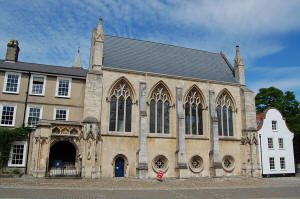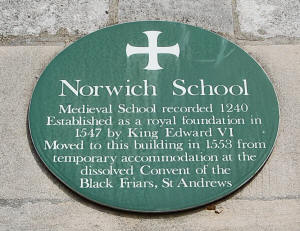| Norwich School (King Edward VI
Grammar School) The Norwich school is located in the Cathedral Close
and is one of the oldest schools in England - dating
back to 1096. Over the years the school has produced a
number of literary pupils and staff.

Norwich School in the
Cathedral Close

Norwich School Plaque
One of the earliest
of the pupils was the poet and dramatist Robert Greene
(1558-1592). Greene, who was born in Norwich and
baptised at St George's Church on Tombland, was famous
for his dissolute lifestyle and for his attack on
Shakespeare in Groats-Worth of Witte. In this
satire, he refers to the Bard as an 'upstart Crow, beautified with our
feathers'. Greene is said to have died of a surfeit of Rhenish wine and pickled herrings.
The novelist and travel writer George Borrow
(1803-1881) attended the school from the age of 13
but his rebellious nature and love of freedom brought
him into conflict with the masters and on one occasion
he was flogged by the headmaster Dr Edward Volpey.
Borrow was more at home on nearby
Mousehold Heath
talking to gypsies such as Jasper Petulengro.
William Taylor, the
translator and radical intellectual taught German at the
school and George Borrow was one of his pupils. Borrow
was a gifted linguist and, in later life, looked back on
Taylor as a mentor.
Augustus Jessop, the historian, was the headmaster of
the Norwich School for 20 years from 1859-1879 before
moving to become the rector at
Scarning. One of Jessop's pupils, was the novelist
James Blyth (1864-1933) who lived for many years in the
village of Fritton in the
Waveney Valley.
More recently the school has produced the novelist,
short story writer
and biographer D. J. Taylor. In fact, Taylor has
recently edited a collection of Norfolk short stories
entitled Dead Men Talking which includes work by
Mary Mann and Elspeth Barker.
|

